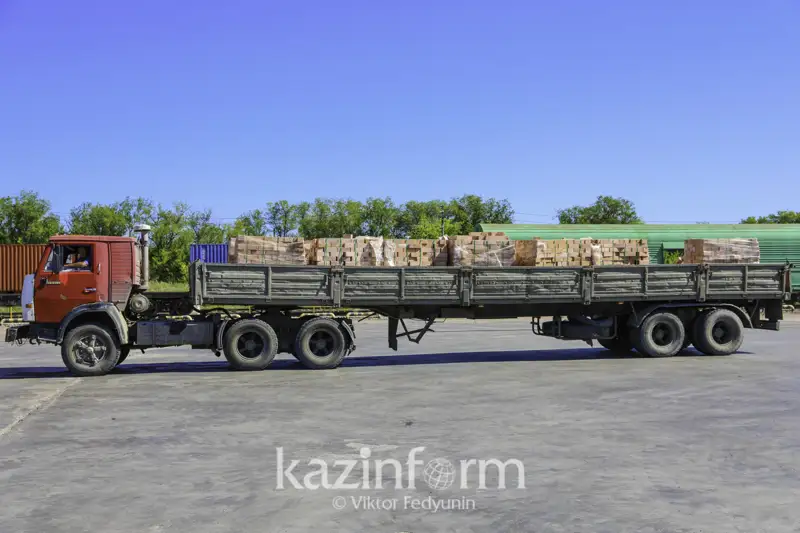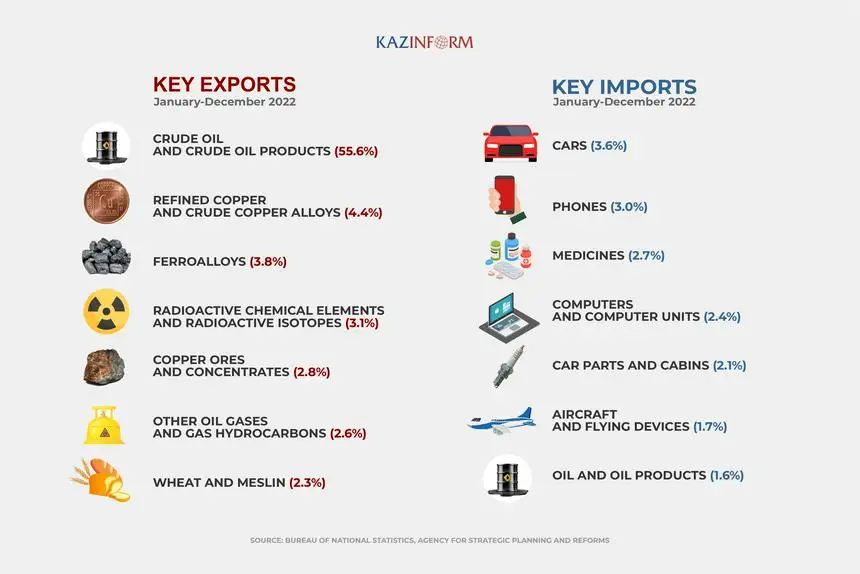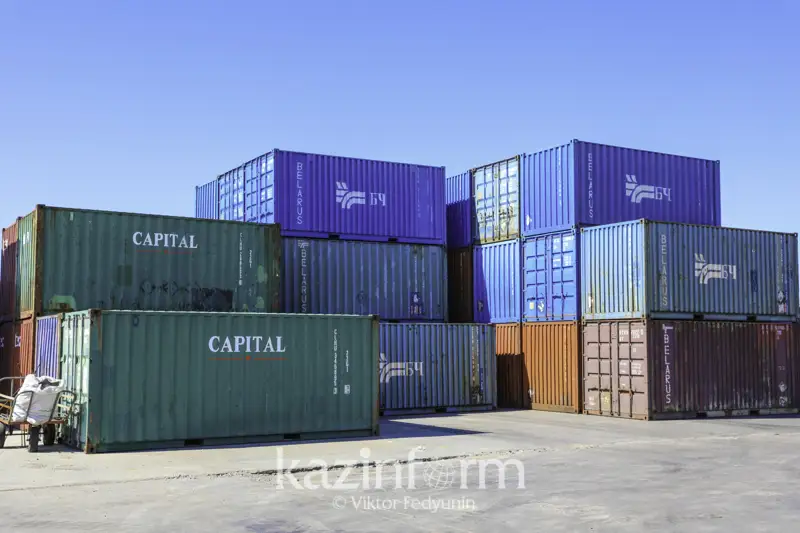Who Kazakhstan trades with most and how?

Besides being ninth largest country in the world, Kazakhstan is the largest landlocked country in the world. The country has been actively involved in foreign trade for decades, relying heavily on its natural resources such as oil, gas, and minerals.
Yet, in the past few years, Kazakhstan's foreign trade has seen significant changes due to several factors, including the COVID-19 pandemic and volatility in global prices for Kazakhstan’s key exports.

Out of record $134.4 billion in 2022, exports reached $84.4 billion, up 39.9 percent in nominal terms, and imports reached $50 billion, up 20.8 percent in nominal terms.
According to the latest data from the Kazakh Ministry of National Economy, foreign trade turnover in January 2023 increased by 15.7 percent, reaching $10.3 billion. Exports rose by 0.4 percent to $6.1 billion, whereas exports of processed goods rose 21.5 percent to $2.1 billion. Imports of goods reached $4.2 billion.
The surge in trade turnover, however, is related to a general rise in prices, said Yernar Serik, an expert at the Astana-based Economic Research Institute.
«According to my estimates, the annual growth of commodity turnover by more than 32 percent is largely due to record prices of commodities and metals, as well as a generally high global inflation rate in 2022. For example, last year we made calculations, which showed that the real growth of Kazakhstan's exports in the first nine months of 2022 amounted to 3 percent, while nominal volume grew by 47.5 percent. That means 44.5 percent growth out of 47.5 percent is a price factor,» he explained in a comment for this story.
In fact, inflation rates globally hit record high. Argentina’s annual inflation rate exceeded 100 percent in February, inflation rate in the United States rose at an annual rate of 6.4 percent and in the EU, inflation, measured by index of consumer prices tripled, reached an annual rate of 9.2 percent.
Who Kazakhstan trades with?
According to Yernar Serik, Kazakhstan’s foreign trade has seen ups and downs in the past five years due to many factors. Yet, trade dynamics remain almost the same.
Kazakhstan traded the most with China, France, Italy, Netherlands, Russia, Spain, South Korea, Türkiye, United States and Uzbekistan.
Italy is Kazakhstan’s largest exporter, accounting for 16.4 percent of exports, according to Kazakhstan’s Bureau of National Statistics data for January to December 2022. Exports to Italy reached $13.9 billion in this period.
Kazakhstan’s key exporters also are China (15.6 percent), Russia (10.4 percent), the Netherlands (6.5 percent), Türkiye (5.6 percent), and the Republic of Korea (5.4 percent), while major importers are Russia (34.7 percent), China (21.9 percent), Germany (4.5 percent), the United States (3.8 percent), Türkiye (3.2 percent), and the Republic of Korea (3.1 percent).

Speaking about the changing trends in Kazakhstan’s foreign trade, Serik said rising trade volumes with China is one of them.
China is among Kazakhstan's largest trading partners besides Russia, and Kazakhstan is its largest trade partner in Central Asia. Last year, the two countries traded a record high $31.2 billion, according to the Kazakh Embassy in China. Heads of the two states agreed to increase trade turnover to $35 billion by 2030.
«Since 2022, there have been gradual changes in Kazakhstan's foreign trade flows. For example, in the structure of the country's imports, China is already almost catching up with Russia, this is due to both a decline in the growth rate of Russian imports and the growth of Chinese imports,» said Serik.
Kazakhstan increased its imports of plastics and rubber from China by 45 percent, textiles and textile products by 23.4 percent and machinery and equipment by 21.4 percent. There was also an increase in supplies of agricultural products to China by 133.7 percent, raw energy products - 58 percent, and chemical products - 25.2 percent.
«We also note that we started to trade more with the Turkic Council countries, which include Türkiye, Uzbekistan, Kyrgyzstan, and Azerbaijan, whose share has reached almost 10 percent of Kazakhstan's trade turnover,» said Serik.
Turkish President Recep Tayyip Erdoğan’s visit to Astana in October 2022 facilitated trade ties between the two countries. The same impetus was given to Kazakh-Uzbek trade relations following Tokayev’s visit to Tashkent in December 2022.
In the context of the Eurasian Economic Union (EAEU), which comprises Russia, Belarus, Kazakhstan, Kyrgyzstan, and Armenia, in 12 months of last year, the trade turnover between Kazakhstan and the EAEU countries amounted to $28.3 billion, which in nominal terms is 6.5 percent more compared to the same period of last year.

Photo: gov.kz
Exports of goods reached $9.7 billion, an increase of 24.3 percent, and imports reached $18.6 billion, a decrease of 0.9 percent. Among the EAEU countries, Russia is a top trade partner accounting for 92.3 percent.
Same dynamics continued in in the beginning of 2023, with trade turnover of Kazakhstan with the EAEU countries reaching $2.1 billion in January, 19.1 percent more in nominal terms compared to the same period of the previous year. Kazakhstan’s export of goods amounted to $932.7 million and imports reached $1.2 billion.
Kazakhstan’s key exports to these countries include ores, oil products, semi-finished non-alloy steel products, bars of unalloyed steel and car components. At the same time, Kazakhstan largely imports rolled steel, ores, uranium, aluminum oxides and hydroxides, and zinc.
Trade ties with the European Union (EU) has seen a surge in the recent years as well. Last year, trade turnover reached a record high $40 billion, 27.6 percent more than in 2021, said Kazakh Deputy Foreign Minister Roman Vassilenko at the Central Communications Service press briefing on March 10.
Besides trade, investments grow as well. The EU is the largest trade and investment partner of Kazakhstan with overall volume of foreign direct investment of over $160 billion. According to Vassilenko, in nine months of 2022, the FDI flow from Europe to Kazakhstan saw a 10 percent increase, exceeding $8 billion. Some 30 percent of Kazakhstan’s foreign trade falls at the EU countries.

«Kazakhstan is the only country in the region to sign and ratify the ‘second generation’ agreement on expanded partnership and cooperation with the EU and its member states. The cooperation areas are not limited to 29 as defined in the agreement. For instance, last year we began working in new areas such as rare Earth metals, green hydrogen, batteries, transport and logistics capacity development, as well as diversification of goods supply chains,» Vassilenko said at the briefing.
What does Kazakhstan export and import?
The main share of goods by export for January-December 2022 included such goods as crude oil and crude oil products derived from bituminous minerals (55.6 percent), refined copper and raw copper alloys (4.4 percent), ferroalloys (3.8 percent), radioactive chemical elements and radioactive isotopes (3.1 percent), copper ores and concentrates (2.8 percent), oil gases and gaseous hydrocarbons (2.6 percent), and wheat and meslin (2.3 percent).

Kazakhstan mainly imports cars (3.6 percent), telephone sets (3 percent), medicines (2.7 percent), computers and computer units (2.4 percent), car units and cabins (2.1 percent), aircraft and flying devices (1.7 percent), and oil and oil products (1.6 percent), among other goods.
Diversification of exports
Kazakhstan has been working to diversify its exports for several years to reduce its reliance on the energy sector and increase the competitiveness of its economy. Diversifying its exports is among key tasks as well, yet a challenging one for the country.

Kazakhstan set an ambitious target to bring the volume of non-resource exports of goods and services to $41 billion, including non-resource goods to $29.5 billion and services - $11.5 billion. These targets are outlined in the country’s Sustainable Economic Growth national project adopted in 2021.
According to the data from the Kazakh Ministry of Trade and Integration, non-resource commodity turnover between Kazakhstan and third countries in 2022 reached $48.6 billion, 33.5 percent higher than in 2021. Export of non-resource goods from Kazakhstan to third countries grew by 24.8 percent in 2022, hitting $18.9 billion.
The main export countries of Kazakhstan in terms of processed goods are China, Uzbekistan, Türkiye and the Netherlands.

Impact of Western sanctions against Russia
With Russia being Kazakhstan’s major trade partner with multiple trade links, the Western sanctions against Russia had impacted the Kazakh economy. Kazakhstan is economically closely tied to Russia and all internal and external shocks in the Russian economy directly affect Kazakhstan.
«The unprecedented sanctions imposed on Russia are already making their mark. In the fourth quarter of 2022, imports from Russia fell by 13 percent, while imports from China rose by 54 percent over the same period. On the export side, we see that many exporters are looking for new markets or new logistic routes bypassing Russia, which will also have an impact in the long run,» said Serik.
Kazakhstan’s efforts to promote domestic exports
The country has also been actively promoting its exports to other markets, particularly focusing on non-oil exports, in a broader effort to diversify its economy.
The Export Acceleration program operated by the QazTrade trade policy development center under the Ministry of Trade and Integration helps Kazakhstan’s non-resource companies to enter foreign markets. In 2023 alone, 110 companies from the food, light, chemical, engineering and service sectors will be able to take part in this program. The selection of candidates lasted through February 24.
Kazakhstan’s companies will also be able to access Alibaba platform, the world’s leading marketplace, under another program managed by QazTrade. A prerequisite for that is the availability of finished products and digitized content on their own site. In 2020-2022, 220 companies and exporters received accounts on Alibaba at the expense of the state.
The center has been implementing these programs for the fourth year, giving an opportunity to nearly 500 Kazakh companies to promote its export potential. The cumulative volume of sales of the participants of the center’s programs in 2022 exceeded $800 million.
Trade partnerships is also promoted through trade and economic missions, where Kazakhstan’s business people, being members of the country’s delegation, visit governmental institutions, trade networks, warehouses, national companies of foreign countries and meet potential partners for research of purchasing power. This year, trade and economic missions will take place in 10 countries, and Kazakhstan’s national stands will be presented at international exhibitions in Shanghai, Istanbul, Dublin, Moscow and Abu Dhabi.
«The main result of government support measures will be improvement of competitiveness indicators and increase of export readiness of Kazakhstan’s enterprises,» said QazTrade Deputy Chairwoman Assel Yegemberdiyeva.
Challenges ahead
Like most countries around the world, Kazakhstan's economy was hit hard by the Covid-19 pandemic. The country's GDP shrank by 2.6 percent in 2020, the first contraction in over a decade. The pandemic disrupted global trade flows and caused a sharp decline in demand for Kazakhstan's key exports, such as oil and metals.
Yet, the country’s economy started to show signs of recovery already in 2021 with foreign trade turnover increasing by 11.4 percent to $101.5 billion. In 2022, Kazakhstan’s economic growth surpassed 3.1 percent, with growth in the real sector reaching 3.2 percent, and in services - 2.5 percent.
Kazakhstan has also been working to expand its exports into new markets beyond its traditional energy export markets. The country has been looking to develop trade relationships with countries in Southeast Asia, South Asia, and Africa.
While Kazakhstan's trade performance has shown signs of improvement in the past two years, the country still faces a number of challenges. The ongoing COVID-19 pandemic continues to disrupt global trade flows and impact Kazakhstan's exports.
«In the 2020 pandemic year, there was an 18 percent decline in Kazakhstan's foreign trade. And in 2021, trade quickly recovered and showed growth of 27 percent, returning to pre-pandemic levels. Such growth was on the background of falling volumes in 2020 [low base effect] and high rates of resumption of global supply chains and removal of COVID-19 restrictions,» said Yernar Serik.
Globally, the impact of COVID-19 pandemic on global trade is close to that during the global financial crisis of 2008-2009, according to the United Nations Conference on Trade and Development (UNCTAD). The consequences include not only a general decline in global demand but also multiple cross-border restrictions and port closures and other logistical disruptions. Though global trade had already begun to recover in the second half of 2020, the pandemic caused an almost $2.5 trillion decline in 2020.
Besides the pandemic, there is a growing competition for foreign markets among countries. Kazakhstan is not an exception and also faces competition from other emerging markets, such as Vietnam and Indonesia, which are seeking to expand their exports to the same markets as Kazakhstan.
While there are challenges ahead, Kazakhstan's efforts to promote non-commodity exports and expand into new markets are promising signs for the country's future economic growth.
